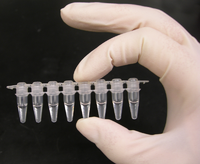
Photo from wikipedia
The use of standardized components and processes in engineering underpins the design-build-test model, and the engineering of biological systems is no different. Substantial efforts to standardize both the components and… Click to show full abstract
The use of standardized components and processes in engineering underpins the design-build-test model, and the engineering of biological systems is no different. Substantial efforts to standardize both the components and the methods to validate the engineered biological systems is ongoing. This study has developed a panel of control materials encoding the commonly used reporter genes GFP and RFP as DNA or RNA molecules. Each panel contained up to six samples with increasingly small copy number differences between the two reporter genes that ranged from 1- to 2-fold differences. These copy number differences represent the magnitude of changes that may need to be measured to validate an engineered system. Using digital PCR (dPCR), we demonstrated that it is possible to quantify changes in both gene and gene transcript numbers both within and between samples down to 1.05-fold. We corroborated these findings using a simple gene circuit within a bacterial model to demonstrate that dPCR was able to precisely identify small changes in gene expression of two transcripts in response to promoter stimulation. Finally, we used our findings to highlight sources of error that can contributed to the measurement uncertainty in the measurement of small ratios in biological systems. Together, the development of a panel of control materials and validation of a high accuracy method for the measurement of small changes in gene expression, this study can contribute to the engineering biology “toolkit” of methods and materials to support the current standardization efforts.
Journal Title: Analytical Chemistry
Year Published: 2022
Link to full text (if available)
Share on Social Media: Sign Up to like & get
recommendations!